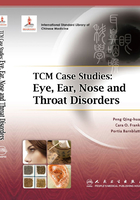
上QQ阅读APP看书,第一时间看更新
Chapter 2 Chalazion
A chalazion is caused by a blockage of the meibomian glands in the eyelid, which produce the fuid that lubricates the eye. The eyelid has approximately 100 meibomian glands. They are located adjacent and posterior to the eyelashes. The blockage occurs in the duct that drains the gland. General symptoms of chalazion include eyelid tenderness, increased tearing, painful swelling of the eyelid and sensitivity to light. A visual examination is usually sufcient to diagnose a chalazion. In rare cases, it can be caused by cancer.
The primary treatment in Western medicine is the application of hot compress to the eye to soften the hardened oil. If left untreated, chalazia will usually resolve within 2-3 months. A history of chalazia will predispose a patient to developing them in the future; therefore, appropriate hygiene, such as washing the eyelid with baby shampoo, is important.
Differentiation between Chalazion and Hordeolum:
● Both conditions are considered sties and both present as lumps in either the upper or lower eyelid. However, a chalazion is not infectious and is rarely painful.
● Chalazion is an eye condition presenting as a round mass in the eyelid that is painless and with a normal skin color. When the swollen mass remains small, the symptoms are not obvious. However, when the size increases, the patient may experience a sinking sensation in the eyelid. The swollen mass subsequently breaks down inside the eyelid. At this stage, a sensation of friction may be felt due to granulation. Examination of the eye will show a round, nut-shaped mass that is painless and has no adhesions, along with swollen areas inside the lid appearing either purplish-red or grayish-blue.
In TCM, this disease is referred to as bāo shēng tán hé (胞生痰核, phlegm node in eyelid). It is the result of the spleen losing its transportive function. Dampphlegm accumulates to create heat, which generates phlegm. Phlegm-heat results in stagnation of qi and blood. They combine to become congested inside the lid, thereby causing the formation of a mass.